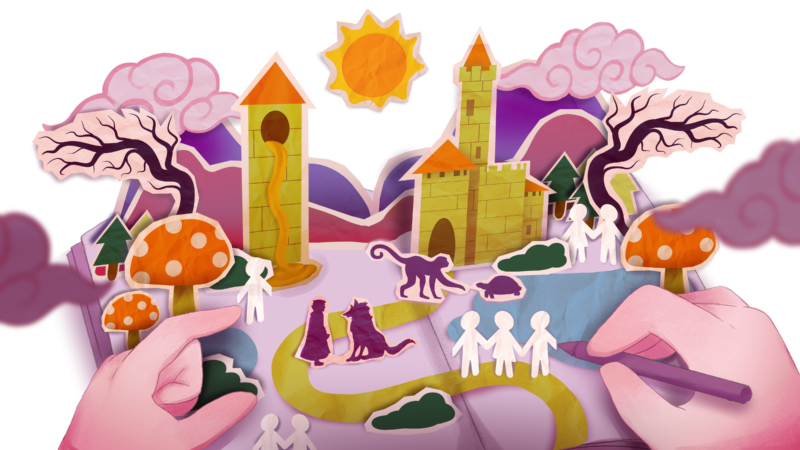The whispered suggestions of manananggals when one hears a mysterious noise during camping trips or sleepovers shows the extent to which Philippine mythology has a place in our lives. Up to now, many Filipino kids are still being told to say “tabi-tabi po (excuse me please)” before passing by some creature’s territory such as forests and trees, or that the distant crying they hear is a tiyanak luring in their next victim.
While most Filipinos are still familiar with the mythical worlds that are embedded into our culture, mythology has never been something totally concrete because these beliefs are composed of stories of ambiguous encounters and events which come from unknown sources. While mythologies really are rooted in storytelling, the fact that it is something that is usually just passed on via word of mouth makes it easy to forget or leave behind as a childhood bedtime story.
But owing to the technology available today, there has been an emergence of more diverse and modern platforms that give our mythological stories more space to evolve along with our contemporary sensibilities. Philippine mythology has come a long way from its roots of pure storytelling and has gained a strong presence in these newer platforms, giving this aspect of our culture a larger voice in modern communities.
Crafting the tales
As previously mentioned, Philippine mythology is a part of our culture that is born out of the tradition of storytelling. This network of beliefs and stories is one of the oldest aspects of our culture, as Filipino folklore dates back to even before the different eras of colonization. But this also means that it predates the era of documentation as introduced by colonizers. The original content and nature of these stories were not written down for generations, regardless of its strong presence in different communities, and it largely depended on its transmission from person to person via word of mouth.
But even with documentation and today’s various media forms, the process of passing on stories by word of mouth still remains. Allan Derain, an instructor from the Filipino Department, comments on how the culture of storytelling can still be seen today. “Ang oral tradition ay very much alive, buhay na buhay pa rin hanggang sa panahon natin ngayon (Oral tradition is very much alive, it’s been very much alive even until our time now).”
Truly, the culture of storytelling can still be seen today. Some of today’s platforms still reflect mythology’s oral tradition. Jerome Ignacio, a super senior majoring in both interdisciplinary studies and theater arts and whose thesis was a set of plays focusing on mythical creatures, discusses how even modern theater is a form of storytelling very much like the old oral tradition.
“[Theater is] in a way, very close to the roots of mythology… kasi you are face to face with the person telling the story, the person telling the story is actually enacting the story being told,” he says. “[Theater] is one way of adhering to its roots.”
However, while both oral tradition and ephemeral media are rich and full of impact, its lack of permanence and further access can make these stories difficult to revisit and appreciate without the aid of some other platforms.
Modern, modernized
Our mythologies are stories in and of themselves. And there is more than one way of telling a story, especially in this day and age where technological developments are used as new platforms for sharing experiences. If, before, an in-depth understanding of these myths were confined to scholars in the academe, today, our technologies have made these myths more accessible—and in turn, digestible—to most people.
Derain points out how technological forms have aided in the telling and retelling of these myths: “Sa isang banda, siguro mas participative yung mga tao, mas maraming senses ngayon nag-cocooperate (On the one hand, [technology] allows people to be more participative, allows more of their senses to cooperate with each other).”
This can be seen in local director Erik Matti’s films Tiktik: The Aswang Chronicles (2012) and Kubot (2014), which featured the titular creatures in a contemporary setting. Tiktik was likewise the first full-length Filipino film shot entirely on green screen, meaning that its special effects were up to par in today’s film industry. Here the traditional sensibilities that were part and parcel of our aswang narratives are blended seamlessly with more modern portrayals of Filipino’s lives.
Ignacio adds, “Nagkakaroon naman ng mythology kasi may common experience tayo, diba? Kaya it follows na yung mismong form ng mythology ay nagbabago rin, because it’s our story (We only have mythology because we have a common experience, right? So it follows that even the very form of mythology changes, because it’s our story).”
The forms today, it seems, are quite diverse: There’s a first-person horror game on Steam, a digital distribution platform, called Nightfall: Escape where players encounter different Philippine mythical creatures. Likewise, there’s a series of mini-documentaries on YouTube by Jordan Clark entitled Creatures of Philippine Mythology, which explores precisely that through a style that is usually reserved for other kinds of stories or experiences. Ignacio cites as well the prevalence of chain messages and of urban myths—these, too, are further proof that though the mediums may change, the sensibility still remains.
Sustaining our stories
It’s clear that there have been advances in the ways we circulate an awareness of and an attentiveness to our myths. But this is just half of the picture—awareness does not always equate to appreciation, and all the more so when our myths are prone to being exoticized or even bastardized. Adding to what he had said about the use of technology, Derain says, “Sa isang banda rin ay mababawasan yung room for imagination (On the other hand, [technology] leaves little room for imagination).”
While there’s nothing overtly wrong about turning to myths for the sake of entertainment, particularly given today’s diverse and accessible forms, it would also do well to understand how these myths were central to the people who once conceived of them. Tracing the evolution of our myths, after all, can allow us to better see what value it can have in our lives today.
Derain cites the development of the image of the aswang: The theory goes that the creature was originally considered as a deity that people had to appease to avoid death. But as the centuries passed and colonizers arrived in the archipelago, it came to be seen more as a trickster-figure, a kind of model in subverting the powers that were. Finally, the way the aswang is generally understood today: Families eventually needed to ensure that their children didn’t stay out too late, and so the creature had to be framed as a monster to effectively play on the imaginations of children.
Our reception and production of mythological stories, then, is always inevitably tied to some context. And even if contexts change, this doesn’t mean that older forms are done away with; Derain explains that the emergence of the printing press didn’t spell the end of the oral tradition.
It seems that we have a special place, then, in this tradition: Precisely as its inheritors and as its future storytellers. As Ignacio puts it, “Yung paggawa natin ngayong ng mga bagong kwento ng mythology, pagpapatuloy lang ‘yan ng mga nasimulan na (Our creating new stories on mythology, that’s just a continuation of what has already been established).”







